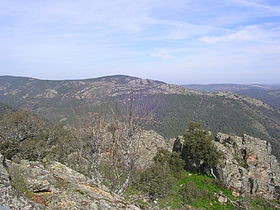Sierra Morena
| Sierra Morena | |
|---|---|

View of the Sierra Morena range in the Despeñaperros area
|
|
| Highest point | |
| Peak | Bañuela |
| Elevation | 1,332 m (4,370 ft) |
| Coordinates | 38°22′N 3°50′W / 38.367°N 3.833°W |
| Dimensions | |
| Length | 450 km (280 mi) E/W |
| Width | 75 km (47 mi) N/S |
| Geography | |
| Location | Provinces of Badajoz, (Extremadura), Ciudad Real, (Castile-La Mancha) and Córdoba, Jaén, Sevilla and Huelva (Andalusia) |
| State/Province | ES-CT |
| Range coordinates | 38°22′N 3°50′W / 38.37°N 3.83°WCoordinates: 38°22′N 3°50′W / 38.37°N 3.83°W |
| Geology | |
| Orogeny | Variscan orogeny |
The Sierra Morena is one of the main systems of mountain ranges in Spain. It stretches for 450 kilometres from east to west across the south of the Iberian Peninsula, forming the southern border of the Meseta Central plateau and providing the watershed between the valleys of the Guadiana to the north and the west, and the Guadalquivir to the south.
Its highest summit is 1,332 m high Bañuela. Other notable peaks are Corral de Borros 1,312 m and Cerro de la Estrella 1,298 m.
The name Sierra Morena has a strong legendary reputation in Spanish culture and tradition, with myths about bandits (Los bandidos de Sierra Morena), a giant snake (El Saetón de Sierra Morena) and a child brought up by wolves (Marcos Rodríguez Pantoja), among others. This range is also mentioned in the famous Mexican song "Cielito Lindo" and in one of the most well known traditional Spanish songs, "Soy Minero", interpreted by Antonio Molina.
The Sierra Morena stretches for 450 km in an E-W direction from the high course of the Guadalmena River in the Sierra del Relumbrar until northwestern Huelva Province, extending into Portugal. The system is the result of the uplift produced by the pressure of the northward-moving African Plate. It is made up of hard Paleozoic rocks such as granite and quartzite, as well as softer materials such as slate and gneiss.
...
Wikipedia

